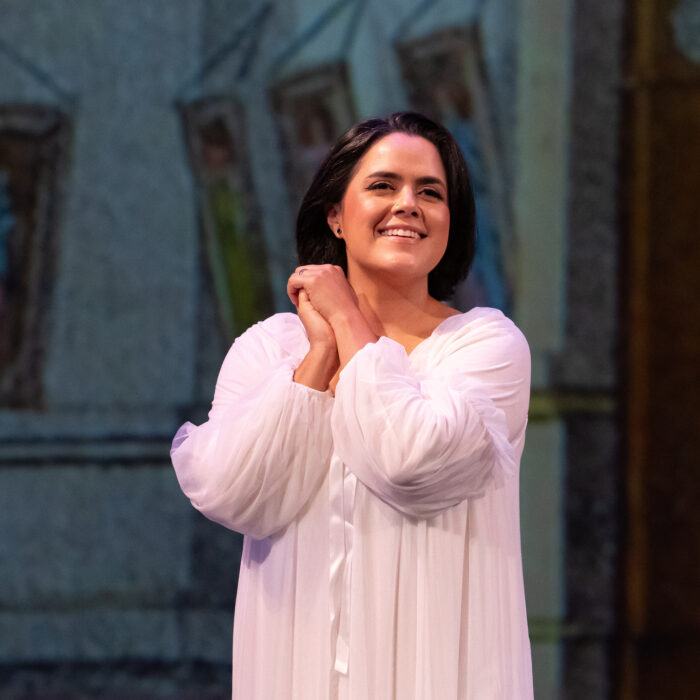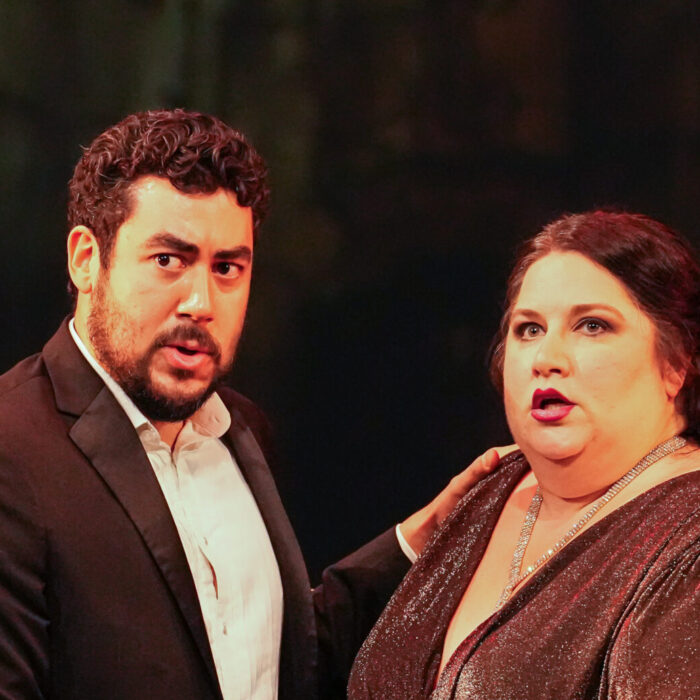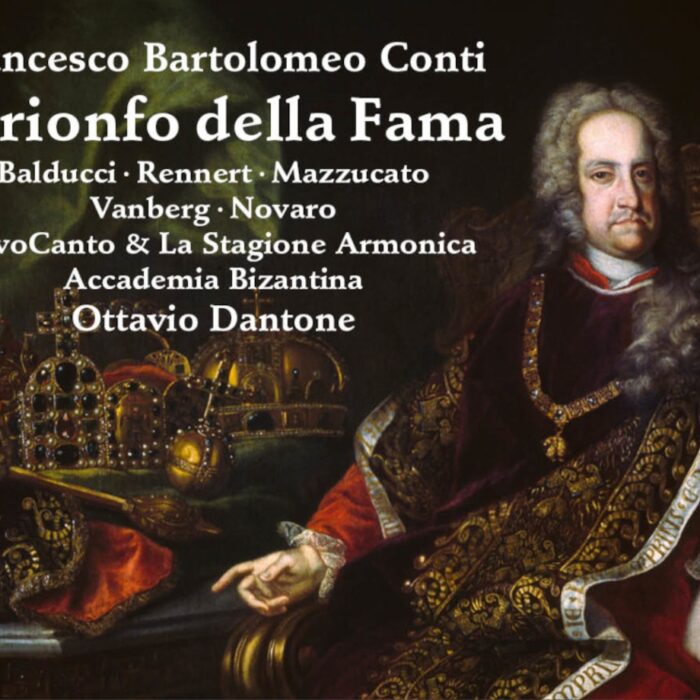
Händel Festspiele Halle 2025 Review: Octavia
A Rare Opportunity To View A Work That Influenced The Young Händel
By Alan Neilson(Photo: Anna Kolata)
One of the main events at this summer’s Halle Händel Festival was a production of Rheinhardt Keiser’s 1705 opera “Octavia” to a libretto by Barthold Feind at the Goethe-Theater in Bad Lauchstädt. Although now a relatively obscure figure, during his lifetime, he was hugely successful and one of the most influential composers of German baroque opera. His works dominated the Hamburg Opera in the Gänsemarkt for decades, and between the years of 1703 and 1707, he was the company’s director and was pivotal in turning the theatre into one of the major cultural centres north of the Alps. He may have been exaggerating when he claimed to have written over 100 operas, but even the Encyclopaedia Britannica places the total as being in excess of 70.
It was his close connection to Händel that no doubt drew the festival’s attention, for it was at the Hamburg Opera that Händel gained his first stage experience and where he developed a complex relationship with the older Keiser. Although based on mutual respect, there was a competitive element, and he was to draw on Keiser’s material for his own operas. From “Octavia,” for example, Händel adapted and incorporated ten arias into his own operas, six of which he used in his 1709 work “Agrippina,” which was also performed at this year’s festival.
In fact, “Octavia” may have been a direct response to Händel’s lost opera, “Nero,” which had been premiered at the Hamburg Opera earlier the same year, with a similar plot with the same main characters.
Set in Rome during the first century AD, the plot revolves around the emperor, Nero, who, now bored with his wife, Octavia, wants to replace her with Ormoena, the wife of his defeated enemy, Tiridates. Nero therefore convinces the dutiful Octavia to commit suicide, which she agrees to. The patrician, Piso, intervenes and persuades her not to go through with it and raises a rebellion against the emperor, while Octavia takes matters into her own hands, and appears as a ghost to terrify Nero, who believes her to be dead. Add in a few subsidiary characters to fill out the love interest, and the narrative unfolds with plenty of intrigue, conflict and tension, which, of course, is all resolved and concludes with a happy ending.
The Goethe Theatre proved to be the perfect venue for the presentation. Dating back to 1802, it has undergone a number of refurbishments over the years, yet still retains its original basic, refined appearance, although it is now equipped with modern lighting and stage technology. Seating approximately 600 people, it has excellent sight lines and pleasing acoustics, making it an excellent venue for intimate performances of baroque opera.
Hecker’s Direction Reveals the Psychological Torment at the Heart of Nero’s Court
The initial impression, however, was not particularly positive. While the audience entered the auditorium and settled into their seats, the relatively young cast, dressed in contemporary, casual clothing, fooled around on the stage and chatted among themselves. It gave the appearance of a student production, far removed from a professional performance. However, it soon became apparent that this was exactly the effect the director, Tilman Hecker, wished to create, which the scenographer, Raimund Orfeo Voigt, and costume designer, Lene Schwind, reinforced by ensuring the focus was always on the characters’ behaviour. The scenery, apart from one scene, in which the stage was turned into a representation of an 18th century theatre, was dull and easily forgettable, while the costumes, which comprised a series of colourful contemporary designs, meant that there was no visual connection to antiquity. In fact, the main criticism of the staging was that it failed to provide a meaningful context.
By presenting the characters, with one or two exceptions, as not yet fully mature adults, Hecker did, however, successfully highlight the themes that lie at the heart of the drama and shine a light on their complex psychologies. Like adolescents who struggle to deal with their sexual desires, moral dilemmas and places within the power hierarchy and society in general, so too the characters inhabiting Nero’s court find themselves facing the same quandaries, thanks to the emperor’s volatile and often crazed behaviour. Their emotional development, therefore, appeared unbalanced, and like adolescents, they descended into posturing, overreaction and occasionally childlike behaviour. Seneca’s philosophical and Davus’ clown-like interjections, like the opinions and influences young people glean from parents and other sources, thus act as conflicting advice on how to deal with the situations they face.
Despite the initial reservations, Hecker’s reading proved to be an insightful presentation and exploration of the characters, although the uninformative staging meant that the nuances of the narrative were not always clear and obvious.
The musical side of the production was under the direction of Wolfgang Katschner, who oversaw splendid performances from the Iautten compagney BERLIN ensemble and the cast, which was comprised of a relatively young, enthusiastic and accomplished group of singers.
Throughout the performance, Katschner paid particular attention to the dramatic dimensions of the music, carefully managing its pace, rhythmic energy and dynamics to ensure that it was carefully aligned to the onstage drama, and in doing so, successfully revealed Keiser’s talent for creating music that promoted Feind’s well-constructed libretto. It was also a clear and detailed performance that highlighted the composer’s lavish and imaginative orchestration: a notable example was the use of five bassoons in Octavia’s aria “Geloso sospetto,” which in this production was given prominence by having them appear alongside Octavia on the stage. Katschner also drew out the beauty of Keiser’s melodic writing with a succession of attractively rendered arias and ensemble pieces.
Many Notable Performances from a Fully Engaged Cast
The committed cast engaged enthusiastically with Hecker’s reading and played up their damaged psychologies, where appropriate.
Although Octavia was a dignified, resolute and loving wife, her willingness to commit suicide purely because it suited Nero suggested she was also not without a complex psychology, which soprano Johanna Kaldewei successfully captured in her beautifully sung and emotionally versatile depiction. Her arias moved across a range of strong emotions, which displayed passion and sensitivity and allowed her to show off her voice to good effect. At times she was gentle yet confident, furnishing the vocal line with delicate, poignant ornamentations, as in the scene in which she pondered suicide, while on other occasions she exploded into rage, notably at Nero, with an angry coloratura display that pushed her voice to the extremes. Her recitatives were crafted with neatly placed emphases and furnished with emotional strength, which brought depth and nuance to her characterisation.
Baritone Tomáš Kral appeared to enjoy himself in bringing to life the emotionally volatile and deeply unpleasant character of Nero, in which he missed no opportunity to gratuitously abuse anyone and everyone with whom he came into contact; simply put, he was vile. Kral possesses a flexible, forceful and expressive voice, which he used confidently and imaginatively to build his character, curling the voice to give it a vicious quality that occasionally bordered on madness, which was exacerbated by occasional gentle, more sensitive passages that brought the necessary instability that defines a psychopath.
Soprano Danae Kontora made a very strong impression as the flirtatious Ormoena. She may have claimed to be a loyal wife with no interest in Nero, but she was certainly not averse to encouraging his advances. The scenes in which she was involved were some of the most dramatically satisfying, but this was mainly owing to her exciting vocal presentation: she has a wonderfully versatile voice and sings with a carefree energy and confidence. Her voice dances lightly across the vocal line, which she ornaments with attractive embellishments, indulges in complex passages of coloratura, and takes audacious leaps in her stride, and it is all done with a sense of ease, in which her pleasing tone is never compromised.
Tenor Gwilym Bowen produced an expressively strong and warm vocal presentation of the rebel, Piso. His arias were beautifully and dramatically well-crafted to bring out his amorous and gallant nature, which was underpinned by his ability to furnish the line with depth and feeling. There was also plenty of subtlety and confidence in his performance, which added to the overall impression and ensured his recitatives carried their full meaning.
Soprano Frieda Jolande Barck is blessed with an attractive stage presence, which was nicely suited to her flirtatious character, Livia. She possesses a clear, fresh and articulate voice with a bright, homogenous tone, underpinned by a secure technique, which she used successfully to create elegantly fashioned arias that charmed the audience, while her recitatives were delivered with an engaging and expressive clarity.
Bass Magnus Piontek brought a degree of gravitas to Nero’s court with a pleasing interpretation of the philosopher Seneca, for which he even wore a cloak that could be mistaken for a toga, although he did spoil it a bit by also wearing a baseball cap. His singing had the requisite depth and authority one would expect of such a figure.
Tenor Christian Miebach clowned around as the low-born Davus but did not really convince in the role. His voice has a pleasing timbre, and he sang well, but it was too easy to become distracted by his over-enthusiastic acting; at times it was just too difficult to ignore the effort that was going into the performance.
Soprano Maria Ladurner showed off her attractive voice and sensitive acting skills as the obsessive Clelia, who only has eyes for Tiridates but finds herself rebuffed at every turn. Her arias were delivered with an alluring sensitivity, in which her delicate phrasing, soft emission and pleasing ornamentations caught the attention.
Countertenor Georg A. Bochow, playing the role of Tiridates, responded to Clelia’s interest in an abusive manner; not that this was in any way surprising given the general levels of contempt found at Nero’s court. He produced an expressive performance that showed off his bright, engaging voice to good effect.
There were a further two tenor roles: Nero’s chamberlain, Lepidus, who is in love with Clelia, and a general, Fabius, who is in love with Livia. They were essayed by Christopher B. Fischer and Johannes Gaubitz, respectively. Although they were both fairly passive figures and provided with few opportunities, both put in solid performances.
Musically, “Octavia” proved to be a pleasing work that showed off Keiser’s talents, especially his facility for penning appealing melodies and moulding the music to support the drama.
It is very unlikely, however, that you would find any commentators who would assert that his work possesses the musical brilliance of a Händel opera.



